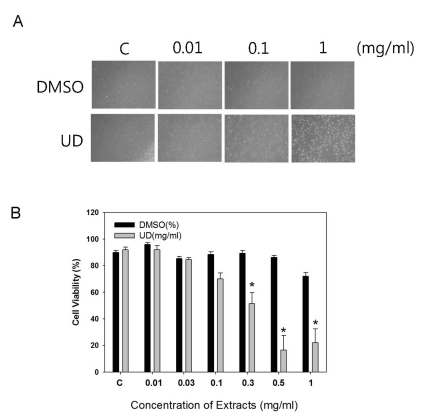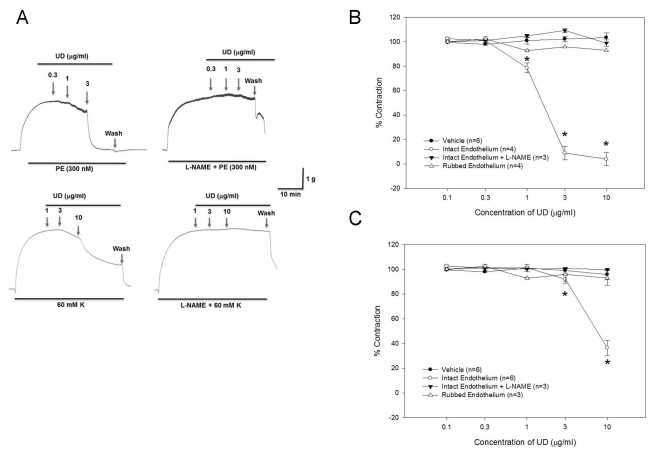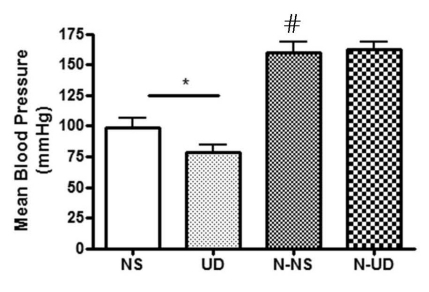INTRODUCTION
METHODS
Plant material and preparation of ethanol extracts
Cell cultures and reagent
Cell viability
Measurement of vasoreactivity in rat aortic rings
Hemodynamic measurements
Statistical analysis
RESULTS
Effect of UD on endothelial cell viability
 | Fig. 1Effect of an ethanol extract of Ulmus davidiana var. japonica (UD) on endothelial cell viability. (A) Representative endothelial cell morphology 24 h after exposure to UD (0.01~1 mg/ml). (B) Cell viability was assessed with propidium iodide staining. Each bar shows the mean±S.E. (n=4). C: untreated control, *p<0.05 versus control. |
Effect of UD on vasocontraction in the rat aorta
 | Fig. 2Vasorelaxing effects of an ethanol extract from Ulmus davidiana var. japonica (UD) in rat aortic rings. (A) Typical tracing of the vasorelaxing effect of UD on endothelium-intact rings. UD evoked vasorelaxation in phenylephrine (300 nM) or high K+ (60 mM)-preconstricted aortic rings. Pretreatment with 0.1 mM L-nitroarginine methyl ester (L-NAME) abrogated UD-induced vasorelaxation. (B) Summarized data for the vasorelaxing effect of UD on phenylephrine-induced contraction. (C) Summarized data for the vasorelaxing effect of UD on high K+ (60 mM)-induced contraction. Vehicle: In endothelium intact rings with DMSO as a vehicle. Intact Endothelium: In endothelium intact rings. Intact endotheium+L-NAME: In endothelium-intact rings pretreated with L-NAME. Rubbed endothelium: In endothelium rubbed rings. Contraction is represented as % contraction of each maximal contraction. Data are the mean±S.E. *p<0.05 versus vehicle. |
The effect of UD on Ca2+ entry: Involvement of NO
 | Fig. 3Effect of an ethanol extract of Ulmus davidiana var. japonica (UD) on intracellular Ca2+ release and Ca2+ influx in rat aortic rings. Phenylephrine-induced contractions were evoked in the absence or presence of extracellular Ca2+ and high K+-induced contractions were evoked by the addition of extracellular Ca2+. Note: High K+-induced contractions were not evoked in the absence of extracellular Ca2+. The aortic rings were pretreated with UD (10µg/ml) or L-nitroarginine methyl ester (L-NAME) for 10 min before the exposure to phenylephrine or high K+. Each bar shows the mean±S.E. (n=5) *p<0.05 versus control. #p<0.05 versus UD alone. |
Effect of UD extracts on blood pressure in anesthetized rats
 | Fig. 4Effect of an ethanol extract of Ulmus davidiana var. japonica (UD) on hemodynamics in anesthetized rats. (A) Typical tracing for the change of arterial blood pressure for 1h after intravenous injection of UD (100 mg/kg). (B) Summarized data of the change of mean arterial pressure (B), ventricular pressure (C), heart rate (D), and ventricular contractility (E) after intravenous injection of UD (10~100 mg/kg). UD was intravenously injected into the jugular vein of rats. Data are the mean±S.E. (n=5~7). *p<0.05 versus vehicle. |
Effect of L-NAME on UD-induced hypotensive action
 | Fig. 5Effect of an ethanol extract of Ulmus davidiana var. japonica (UD) on mean arterial blood pressure in anesthetized rats. Mean arterial blood pressure which was taken in 10 min after injection of normal saline (NS), 100 mg/kg of UD (UD), L-NAME+normal saline (N-NS) and L-NAME+100 mg/kg of UD (N-UD) in anesthetized rats. UD or normal saline were intravenously injected into the jugular vein of rats. L-NAME (40 mg/kg) was injected in intraperitoneum. Data are the mean±S.E. (n=4~5). *p<0.05 for NS versus UD. #p<0.05 for NS versus N-NS. |




 PDF
PDF ePub
ePub Citation
Citation Print
Print


 XML Download
XML Download